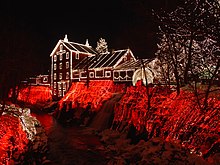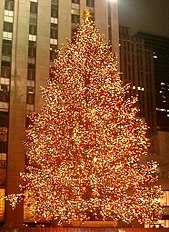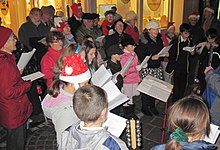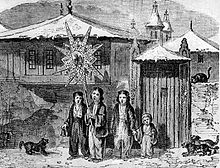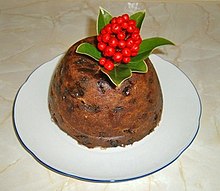Merry Christmas to you and your family. This is a special time of the year. A time of giving and being with family and friends. It is also a religious holiday for many celebrating Christ's birth. Speaking of Christmas , WellLife has a wonderful assessment of holiday related articles from how to have a meaningful Christmas to holiday baking recipes.Also, Focus on Mental Wellness offers a touching article that discusses how to give with your heart.If you are interested in contacting me for various writing projects, you can reach me by Email.
Christmas as a holiday has evolved over the years. Here is a complete look of this wonderful holiday from all different angles brought to you by Wickepedia.
Christmas Day is celebrated as a major festival and public holiday in countries around the world, including many whose populations are mostly non-Christian. In some non-Christian countries, periods of former colonial rule introduced the celebration (e.g. Hong Kong); in others, Christian minorities or foreign cultural influences have led populations to observe the holiday. Countries such as Japan, where Christmas is popular despite there being only a small number of Christians, have adopted many of the secular aspects of Christmas, such as gift-giving, decorations and Christmas trees.
Countries in which Christmas is not a formal public holiday include China, (excepting Hong Kong and Macao), Japan, Saudi Arabia, Algeria, Thailand, Iran, Turkey and North Korea. Christmas celebrations around the world can vary markedly in form, reflecting differing cultural and national traditions.
Among countries with a strong Christian tradition, a variety of Christmas celebrations have developed that incorporate regional and local cultures. For Christians, participating in a religious service plays an important part in the recognition of the season. Christmas, along with Easter, is the period of highest annual church attendance.
In Catholic countries, people hold religious processions or parades in the days preceding Christmas. In other countries, secular processions or parades featuring Santa Claus and other seasonal figures are often held. Family reunions and the exchange of gifts are a widespread feature of the season. Gift giving takes place on Christmas Day in most countries. Others practice gift giving on December 6, Saint Nicholas Day, and January 6, Epiphany.
Commemorating Jesus' birth

Anbetung der Hirten (Adoration of the Shepherds) (c. 1500–10), by Italian painter Giorgio da Castelfranco

On Christmas Day, the Christ Candle in the center of the Advent wreath is traditionally lit in many church services.
Christians celebrate Christmas in various ways. In addition to this day being one of the most important and popular for the attendance of church services, there are other devotions and popular traditions. In some Christian denominations, children re-enact the events of the Nativity with animals to portray the event with more realism or sing carols that reference the event. Some Christians also display a small re-creation of the Nativity, known as a Nativity scene or crèche, in their homes, using figurines to portray the key characters of the event. Prior to Christmas Day, the Eastern Orthodox Church practices the 40-day Nativity Fast in anticipation of the birth of Jesus, while much of Western Christianity celebrates four weeks of Advent. The final preparations for Christmas are made on Christmas Eve, and many families' major observation of Christmas actually falls in the evening of this day.
A long artistic tradition has grown of producing painted depictions of the nativity in art. Nativity scenes are traditionally set in a stable with livestock and include Mary, Joseph, the infant Jesus in the manger, the three wise men, the shepherds and their sheep, the angels, and the Star of Bethlehem.
Decorations
Main article: Christmas decoration
See also: Christmas tree, Nativity scene, Christmas lights, Christmas stocking, and Christmas ornament
The practice of putting up special decorations at Christmas has a long history. In the 15th century, it was recorded that in London it was the custom at Christmas for every house and all the parish churches to be "decked with holm, ivy, bays, and whatsoever the season of the year afforded to be green". The heart-shaped leaves of ivy were said to symbolize the coming to earth of Jesus, while holly was seen as protection against pagans and witches, its thorns and red berries held to represent the Crown of Thorns worn by Jesus at the crucifixion and the blood he shed.Nativity scenes are known from 10th-century Rome. They were popularised by Saint Francis of Asissi from 1223, quickly spreading across Europe. Different types of decorations developed across the Christian world, dependent on local tradition and available resources. The first commercially produced decorations appeared in Germany in the 1860s, inspired by paper chains made by children. In countries where a representation of the Nativity Scene is very popular, people are encouraged to compete and create the most original or realistic ones. Within some families, the pieces used to make the representation are considered a valuable family heirloom.
The traditional colors of Christmas are green and red. White, silver and gold are also popular. Red symbolizes the blood of Jesus, which was shed in his crucifixion, while green symbolizes eternal life, and in particular the evergreen tree, which does not lose its leaves in the winter.
From Germany the custom was introduced to Britain, first via Queen Charlotte, wife of George III, and then more successfully by Prince Albert during the reign of Queen Victoria. By 1841 the Christmas tree had become even more widespread throughout Britain. By the 1870s, people in the United States had adopted the custom of putting up a Christmas tree. Christmas trees may be decorated with lights and ornaments.
Since the 19th century, the poinsettia, a native plant from Mexico, has been associated with Christmas. Other popular holiday plants include holly, mistletoe, red amaryllis, and Christmas cactus. Along with a Christmas tree, the interior of a home may be decorated with these plants, along with garlands and evergreen foliage. The display of Christmas villages has also become a tradition in many homes during this season. The outside of houses may be decorated with lights and sometimes with illuminated sleighs, snowmen, and other Christmas figures.
Other traditional decorations include bells, candles, candy canes, stockings, wreaths, and angels. Both the displaying of wreaths and candles in each window are a more traditional Christmas display. The concentric assortment of leaves, usually from an evergreen, make up Christmas wreaths and are designed to prepare Christians for the Advent season. Candles in each window are meant to demonstrate the fact that Christians believe that Jesus Christ is the ultimate light of the world.
Christmas lights and banners may be hung along streets, music played from speakers, and Christmas trees placed in prominent places. It is common in many parts of the world for town squares and consumer shopping areas to sponsor and display decorations. Rolls of brightly colored paper with secular or religious Christmas motifs are manufactured for the purpose of wrapping gifts. In some countries, Christmas decorations are traditionally taken down on Twelfth Night, the evening of January 5.
Music and carols
Main article: Christmas music
In the 9th and 10th centuries, the Christmas "Sequence" or "Prose" was introduced in North European monasteries, developing under Bernard of Clairvaux into a sequence of rhymed stanzas. In the 12th century the Parisian monk Adam of St. Victor began to derive music from popular songs, introducing something closer to the traditional Christmas carol.
By the 13th century, in France, Germany, and particularly, Italy, under the influence of Francis of Asissi, a strong tradition of popular Christmas songs in the native language developed. Christmas carols in English first appear in a 1426 work of John Awdlay, a Shropshire chaplain, who lists twenty-five "caroles of Cristemas", probably sung by groups of wassailers, who went from house to house.
The songs we know specifically as carols were originally communal folk songs sung during celebrations such as "harvest tide" as well as Christmas. It was only later that carols began to be sung in church. Traditionally, carols have often been based on medieval chord patterns, and it is this that gives them their uniquely characteristic musical sound. Some carols like "Personent hodie", "Good King Wenceslas", and "The Holly and the Ivy" can be traced directly back to the Middle Ages. They are among the oldest musical compositions still regularly sung. Adeste Fidelis (O Come all ye faithful) appears in its current form in the mid-18th century, although the words may have originated in the 13th century.
Felix Mendelssohn wrote a melody adapted to fit Wesley's words. In Austria in 1818 Mohr and Gruber made a major addition to the genre when they composed "Silent Night" for the St. Nicholas Church, Oberndorf. William B. Sandys' Christmas Carols Ancient and Modern (1833) contained the first appearance in print of many now-classic English carols, and contributed to the mid-Victorian revival of the festival.
Sorry, your browser either has JavaScript disabled or does not have any supported player.
You can download the clip or download a player to play the clip in your browser.
You can download the clip or download a player to play the clip in your browser.
Traditional cuisine
Further information: Christmas dinner
In Poland and other parts of eastern Europe and Scandinavia, fish often is used for the traditional main course, but richer meat such as lamb is increasingly served. In Germany, France and Austria, goose and pork are favored. Beef, ham and chicken in various recipes are popular throughout the world. The Maltese traditionally serve Imbuljuta tal-Qastan, a chocolate and chestnuts beverage, after Midnight Mass and throughout the Christmas season. Slovaks prepare the traditional Christmas bread potica, bûche de Noël in France, panettone in Italy, and elaborate tarts and cakes. The eating of sweets and chocolates has become popular worldwide, and sweeter Christmas delicacies include the German stollen, marzipan cake or candy, and Jamaican rum fruit cake. As one of the few fruits traditionally available to northern countries in winter, oranges have been long associated with special Christmas foods.
Cards
Main article: Christmas card
File:Julekort.jpg
Christmas cards with angels, Scandinavian "nisser", Father Christmas, snow men and hearts
Christmas cards are purchased in considerable quantities, and feature artwork, commercially designed and relevant to the season. The content of the design might relate directly to the Christmas narrative with depictions of the Nativity of Jesus, or Christian symbols such as the Star of Bethlehem, or a white dove which can represent both the Holy Spirit and Peace on Earth. Other Christmas cards are more secular and can depict Christmas traditions, mythical figures such as Santa Claus, objects directly associated with Christmas such as candles, holly and baubles, or a variety of images associated with the season, such as Christmastide activities, snow scenes and the wildlife of the northern winter. There are even humorous cards and genres depicting nostalgic scenes of the past such as crinolined shoppers in idealized 19th century streetscapes.
Some prefer cards with a poem, prayer or Biblical verse; while others distance themselves from religion with an all-inclusive "Season's greetings".
Commemorative stamps
Main article: Christmas stamp
A number of nations have issued commemorative stamps at Christmastide. Postal customers will often use these stamps to mail Christmas cards, and they are popular with philatelists. These stamps are regular postage stamps, unlike Christmas seals, and are valid for postage year-round. They usually go on sale some time between early October and early December, and are printed in considerable quantities.In 1898 a Canadian stamp was issued to mark the inauguration of the Imperial Penny Postage rate. The stamp features a map of the globe and bears an inscription "XMAS 1898" at the bottom. In 1937, Austria issued two "Christmas greeting stamps" featuring a rose and the signs of the zodiac. In 1939, Brazil issued four semi-postal stamps with designs featuring the three kings and a star of Bethlehem, an angel and child, the Southern Cross and a child, and a mother and child.
Both the US Postal Service and the Royal Mail regularly issue Christmas-themed stamps each year.
Gift giving
See also: Gift economy
The exchanging of gifts is one of the core aspects of the modern Christmas celebration, making the Christmas season the most profitable time of year for retailers and businesses throughout the world. Gift giving was common in the Roman celebration of Saturnalia, an ancient festival which took place in late December and may have influenced Christmas customs. On Christmas, Christians exchange gifts on the basis that the tradition is associated St. Nicholas with Christmas, and that gifts of gold, frankincense and myrrh were given to the infant Jesus by the Biblical Magi.Gift-bearing figures
Main articles: Santa Claus and Father Christmas
See also: Saint Nicholas and Basil of Caesarea
The best known of these figures today is red-dressed Santa Claus, of diverse origins. The name Santa Claus can be traced back to the Dutch Sinterklaas, which means simply Saint Nicholas. Nicholas was Bishop of Myra, in modern day Turkey, during the 4th century. Among other saintly attributes, he was noted for the care of children, generosity, and the giving of gifts. His feast on December 6 came to be celebrated in many countries with the giving of gifts.
Saint Nicholas traditionally appeared in bishop's attire, accompanied by helpers, inquiring about the behaviour of children during the past year before deciding whether they deserved a gift or not. By the 13th century, Saint Nicholas was well known in the Netherlands, and the practice of gift-giving in his name spread to other parts of central and southern Europe. At the Reformation in 16th–17th century Europe, many Protestants changed the gift bringer to the Christ Child or Christkindl, corrupted in English to Kris Kringle, and the date of giving gifts changed from December 6 to Christmas Eve.
The modern popular image of Santa Claus, however, was created in the United States, and in particular in New York. The transformation was accomplished with the aid of notable contributors including Washington Irving and the German-American cartoonist Thomas Nast (1840–1902). Following the American Revolutionary War, some of the inhabitants of New York City sought out symbols of the city's non-English past. New York had originally been established as the Dutch colonial town of New Amsterdam and the Dutch Sinterklaas tradition was reinvented as Saint Nicholas.
In 1809, the New-York Historical Society convened and retroactively named Sancte Claus the patron saint of Nieuw Amsterdam, the Dutch name for New York City. At his first American appearance in 1810, Santa Claus was drawn in bishops' robes. However as new artists took over, Santa Claus developed more secular attire. Nast drew a new image of "Santa Claus" annually, beginning in 1863. By the 1880s, Nast's Santa had evolved into the robed, fur clad, form we now recognize, perhaps based on the English figure of Father Christmas. The image was standardized by advertisers in the 1920sand continues through the present day: indeed, some have made a career out of portraying Santa Claus, particularly if they are slightly overweight middle aged men with beards and a jolly disposition.
Father Christmas, a jolly, well nourished, bearded man who typified the spirit of good cheer at Christmas, predates the Santa Claus character. He is first recorded in early 17th century England, but was associated with holiday merrymaking and drunkenness rather than the bringing of gifts. In Victorian Britain, his image was remade to match that of Santa. The French Père Noël evolved along similar lines, eventually adopting the Santa image. In Italy, Babbo Natale acts as Santa Claus, while La Befana is the bringer of gifts and arrives on the eve of the Epiphany. It is said that La Befana set out to bring the baby Jesus gifts, but got lost along the way. Now, she brings gifts to all children. In some cultures Santa Claus is accompanied by Knecht Ruprecht, or Black Peter. In other versions, elves make the toys. His wife is referred to as Mrs. Claus.
Current tradition in several Latin American countries (such as Venezuela and Colombia) holds that while Santa makes the toys, he then gives them to the Baby Jesus, who is the one who actually delivers them to the children's homes, a reconciliation between traditional religious beliefs and the iconography of Santa Claus imported from the United States.
In South Tyrol (Italy), Austria, Czech Republic, Southern Germany, Hungary, Liechtenstein, Slovakia and Switzerland, the Christkind (Ježíšek in Czech, Jézuska in Hungarian and Ježiško in Slovak) brings the presents. Greek children get their presents from Saint Basil on New Year's Eve, the eve of that saint's liturgical feast.The German St. Nikolaus is not identical with the Weihnachtsmann (who is the German version of Santa Claus/Father Christmas). St. Nikolaus wears a bishop's dress and still brings small gifts (usually candies, nuts and fruits) on December 6 and is accompanied by Knecht Ruprecht. Although many parents around the world routinely teach their children about Santa Claus and other gift bringers, some have come to reject this practice, considering it deceptive.
Date of celebration
In the earliest centuries of Christianity, no particular day of the year is known to have been associated with the birth of Jesus. Various dates were speculated: May 20, April 18 or 19, March 25, January 2, November 17 or 20. When celebration on a particular date began, January 6 prevailed at least in the East; but, except among Armenians (the Armenian Apostolic Church and the Armenian Catholic Church), who continue to celebrate the birth on January 6, December 25 eventually won acceptance everywhere.The birth of Jesus was announced in Luke 2:11, "For unto you is born this day in the city of David a Saviour, which is Christ the Lord." Moreover, the belief that God came into the world in the form of man to atone for the sins of humanity is considered to be the primary purpose in celebrating Christmas.
In the early 4th century, the church calendar in Rome contained Christmas on December 25 and other holidays placed on solar dates: "It is cosmic symbolism...which inspired the Church leadership in Rome to elect the southern solstice, December 25, as the birthday of Christ, and the northern solstice as that of John the Baptist, supplemented by the equinoxes as their respective dates of conception. While they were aware that pagans called this day the 'birthday' of Sol Invictus, this did not concern them and it did not play any role in their choice of date for Christmas," according to modern scholar S.E. Hijmans.
Around the year 386 John Chrysostom delivered a sermon in Antioch in favour of adopting the 25 December celebration also in the East, since, he said, the conception of Jesus (Luke 1:26) had been announced during the sixth month of Elisabeth's pregnancy with John the Baptist (Luke 1:10–13), which he dated from the duties Zacharias performed on the Day of Atonement during the seventh month of the Hebrew calendar Ethanim or Tishri (Lev. 16:29, 1 Kings 8:2) which falls from late September to early October. That shepherds watched the flocks by night in the fields in the winter time is supported by the phrase "frost by night" in Genesis 31:38–40. A special group known as the shepherds of Migdal Eder (Gen. 35:19–21, Micah 4:8) watched the flocks by night year round pastured for Temple Sacrifice near Bethlehem.[89][90]
In the early 18th century, some scholars proposed alternative explanations. Isaac Newton argued that the date of Christmas, celebrating the birth of him whom Christians consider to be the "Sun of righteousness" prophesied in Malachi 4:2, was selected to correspond with the southern solstice, which the Romans called bruma, celebrated on December 25.] In 1743, German Protestant Paul Ernst Jablonski argued Christmas was placed on December 25 to correspond with the Roman solar holiday Dies Natalis Solis Invicti and was therefore a "paganization" that debased the true church.It has been argued that, on the contrary, the Emperor Aurelian, who in 274 instituted the holiday of the Dies Natalis Solis Invicti, did so partly as an attempt to give a pagan significance to a date already important for Christians in Rome. In 1889, Louis Duchesne proposed that the date of Christmas was calculated as nine months after the Annunciation, the traditional date of the conception of Jesus.[

